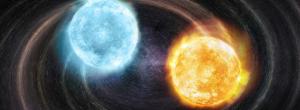Astronomers Detect First Double Helium-Core White Dwarf Gravitational Wave Source
Scientists at the Center for Astrophysics | Harvard & Smithsonian today announced the detection of J2322+0509, a detached binary white dwarf composed of two helium-core stars with a short orbital period. It is the first gravitational wave source of its kind ever detected.

Astronomers Detect First Double Helium-Core White Dwarf Gravitational Wave Source
"Theories predict that there are many double helium-core white dwarf binaries out there," said Dr. Warren Brown, CfA astronomer and lead author on the study. “This detection provides an anchor for those models, and for doing future experiments so that we can find more of these stars and determine their true numbers.”
The star will be used for verification on the much-anticipated LISA (Laser Interferometer Space Antenna) gravitational wave observatory, planned for launch in 2034, said Dr. Mukremin Kilic, from the University of Oklahoma, and a co-author on the study. "Verification binaries are important because we know that LISA will see them within a few weeks of turning on the telescopes," said Kilic. "There’s only a handful of LISA sources that we know of today. The discovery of the first prototype of a new class of verification binary puts us well ahead of where anyone could have anticipated."
Early on, scientists found J2322+0509 a challenge to study, collecting critical information about the class of stars that will shape future scientific results through multiple avenues. Optical light curve studies yielded no result, said Brown. "This binary had no light curve. We couldn't detect a photometric signal because there isn’t one." Spectroscopic studies, however, shaped the story of a difficult-to-detect yet scientifically important binary system, and revealed its orbital motion.
"We're finding that the binaries that might be the hardest to detect may actually be the strongest sources of gravitational waves," said Brown. "This binary was difficult to detect because it is oriented face-on to us, like a bull's eye, rather than edge-on. Remarkably, the binary's gravitational waves are 2.5 times stronger at this orientation than if it were orientated edge-on like an eclipsing binary."
The pair also held another surprise for researchers. With an orbital period of 1201 seconds, or just over 20 minutes, the pair is confirmed as having the third shortest period of all known detached binaries. "This pair is at the extreme end of stars with short orbital periods," said Brown. "And the orbit of this pair of objects is decaying. The gravitational waves that are being emitted are causing the pair to lose energy; in six or seven million years they will merge into a single, more-massive white dwarf."
Spectroscopic data for J2322+0509 was collected using the MMT telescope at the Fred Lawrence Whipple Observatory in Amado, Arizona; the Magellan Baade telescope at the Las Campanas Observatory in Chile; and, the Gemini-North telescope on Mauna Kea, Hawaii.
Source: Center for Astrophysics, Harvard & Smithsonian
- 308 reads
Human Rights
Ringing FOWPAL’s Peace Bell for the World:Nobel Peace Prize Laureates’ Visions and Actions

Protecting the World’s Cultural Diversity for a Sustainable Future

The Peace Bell Resonates at the 27th Eurasian Economic Summit

Declaration of World Day of the Power of Hope Endorsed by People in 158 Nations

Puppet Show I International Friendship Day 2020

